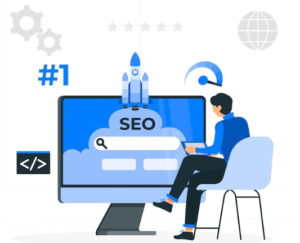Introduction:
The world of finance and technology is constantly changing, making it difficult for fintech companies to stay ahead. With the rise of new technologies and changes in customer behavior, fintech companies need to keep up-to-date on the latest trends in marketing.
That is where these marketing strategies come in. We have compiled a list of must-follow marketing strategies for your fintech company in 2023 to help you stay ahead in the game.
If you are a fintech company looking to grow and stay competitive, this blog post is for you!
In this blog post, we will talk in detail about the various strategies that you must follow in order to market your fintech company in 2023 successfully.
We will cover topics such as:
- Understanding the Fintech Consumer
- Utilizing Emerging Technologies
- Creating Engaging and Consistent Content
- Exploring Social Media Platforms
By the end of this blog, you will have a comprehensive understanding of how to market your fintech company this year effectively.
But before diving into the strategies, let’s start with the basics!
What is Fintech Company?

Fintech companies are companies that use technology to provide financial services and products. They offer innovative solutions to traditional banking and financial institutions while often having lower costs and faster turnaround times.
Fintech companies offer a wide range of services and products that can include mobile banking, investing, peer-to-peer payments, digital currencies, and more.
As the fintech industry goes on to grow, it is essential for fintech companies to stay ahead of the competition and keep up with changes, both in technology and consumer behavior.
Now that we have established what a fintech company is and why it is vital for them to stay ahead of the curve, let’s understand what fintech marketing is and why is a fintech marketing strategy different from other companies.
Marketing For Fintech: What Exactly Is It?
Marketing for fintech is the process of promoting a fintech company’s products and services to potential customers.
This can include traditional marketing methods, such as print ads and direct mail campaigns, and digital marketing tactics, like SEO optimization, email marketing, and social media advertising.
Because of the nature of their business, fintech companies must focus on marketing strategies that are tailored to the industry.
This means understanding the unique needs of fintech consumers, leveraging new technologies, personalizing the customer experience, and utilizing data-driven insights.
By following a well-tailored fintech marketing strategy, companies can ensure they are staying ahead of their competition and maximizing their marketing efforts in 2023, building a solid foundation for years to come.
How is a Fintech Marketing Strategy Different from Other Companies?
Fintech marketing is unique as it requires a thorough understanding of the industry and its customers.
As a fintech company, you must be knowledgeable not only of your own product offerings but also of the technologies and customer preferences that exist in the space.
For instance, fintech companies must also be mindful of the regulations and policies that govern the industry. For example, fintech companies must comply with data privacy laws such as GDPR and use secure payment methods to ensure their customer data is safe.
By understanding such vital components, fintech companies can tailor their marketing strategies to the needs of their target audience.
Marketing For Fintech: The Ten Must-Follow Strategies for 2023, Explained
Now that we have examined the basics of fintech marketing, let’s dive into some specific strategies that you should be following in order to successfully market your fintech company in 2023.
#1 Fintech Marketing Strategy: Identify, Understand, and Educate Your Customers

The first and primary fintech marketing strategy is to identify your target customer. You need to understand who they are, what their financial goals and needs are, where they consume content, and what kind of language resonates with them.
When you have identified your target audience, you can educate them about your product or service, as well as the broader fintech industry.
How to Implement This Strategy?
For this purpose, you can use content marketing forms, such as blog posts and videos. By providing such valuable information, you will be helping your customers make informed decisions.
Additionally, you can create webinars and tutorials to help customers understand the fintech sector and its offerings.
It is also essential to be active on social media and connect with potential customers.
#2 Fintech Marketing Strategy: Leverage Automation Technologies
Technology is rapidly changing and evolving, which means automation tools are becoming more advanced and efficient.
Fintech companies should leverage the technologies, such as artificial intelligence, machine learning, and automation, to make their marketing efforts more effective.
For instance, automation tools can help with customer segmentation, streamlining your marketing activities, and saving time.
How to Implement This Strategy?
You can make use of automation tools, such as marketing automation software, for tasks such as email campaigns and customer segmentation.
You can also use marketing automation tools to monitor customer behavior and adjust your strategy accordingly. For instance, you can use predictive analytics to anticipate changes in the fintech market and respond quickly.
You can use automation tools, such as chatbots, to help customers find the information they need.
By leveraging automation technologies, you will be able to increase your marketing efficiency and focus on other important aspects of your business.
#3 Fintech Marketing Strategy: Leverage the Power of Collaboration
Collaboration campaigns can be a powerful way to market your fintech company. By partnering with other organizations, you can reach more customers and build strong relationships with them.
You can also develop joint products and services that can be useful to your customers.
How to Implement This Strategy?
You can start by identifying other organizations, such as banks, credit unions, and financial advisors, who have an interest in the fintech space. Then, reach out to them and discuss possible collaboration opportunities.
You can also join forces with non-financial organizations to target customers who are not familiar with the fintech sector.
By collaborating with other organizations, you can reach a wider audience and gain more exposure.
#4 Fintech Marketing Strategy: Utilize Influencer Marketing
An effective way to market your fintech company can be influencer marketing. By partnering with influencers in the financial industry, you can get your message across and explain how your offerings can benefit their followers.
How to Implement This Strategy?
You should start by researching influencers in the fintech sector who are relevant to your product or service. Reach out to them and discuss possible collaborations.
You can also use influencer marketing platforms to find the right influencers for your campaign.
Once you have identified the influencers, create content that resonates with their followers. This could include videos, blog posts, or podcasts.
By leveraging influencer marketing, you can quickly reach a large audience and increase your brand awareness.
#5 Fintech Marketing Strategy: Invest in SEO

Search Engine Optimization (SEO) is an essential marketing strategy for fintech companies. By optimizing your content for several search engines, you can reach more potential customers and increase website traffic.
How to Implement This Strategy?
You can start by understanding your target audience and what keywords they are using to search for products or services related to fintech.
Once you have identified the keywords, create content that is optimized for those keywords and implement SEO best practices.
You can also use tools, such as Google Search Console, to measure your progress and track the performance of your SEO efforts.
By investing in SEO, you will be able to reach more potential customers and increase your visibility online.
#6 Fintech Marketing Strategy: Focus on Quality and Consistency
Another essential strategy is to focus on quality and consistency when marketing a fintech company.
Quality content will help you build trust with your customers and increase the likelihood of them using your products or services.
You should also focus on creating content that is consistent in terms of look and feel. This will help you establish a strong brand identity and create an impression of reliability and trustworthiness.
How to Implement This Strategy?
You should start by creating content that is informative and engaging. Then, utilize relevant visuals, such as videos and images, to break up the text and make the content more interesting.
Once you have created your content, you should ensure that it is consistent in terms of look, feel, and tone. You should also use the same logos, fonts, and color palettes on all of your content to reinforce your brand identity.
Finally, you should focus on providing quality customer service to ensure that all of your customers have a positive experience when using your products or services.
#7 Fintech Marketing Strategy: Explore Different Channels
In order to reach more potential customers, you should explore different channels for your marketing efforts. This includes both traditional and digital channels, such as print media, radio, television, and social media.
How to Implement This Strategy?
You should start by analyzing your target audience and determining which channels they are most likely to use.
Once you have identified the channels, create content that is tailored to those platforms. This could include videos, blog posts, or podcasts.
Finally, you should use strategies such as A/B testing to measure the effectiveness of your campaigns and optimize them accordingly.
By exploring different channels, you can quickly reach a large audience and increase your brand visibility.
#8 Fintech Marketing Strategy: Experiential Marketing
Experiential marketing is a great way to engage potential customers and increase brand awareness.
This involves creating memorable experiences that allow potential customers to interact with your products or services. Experiential marketing can be done in a variety of ways, such as events, pop-up stores, or virtual reality.
How to Implement This Strategy?
You should start by understanding the needs of your target audience and creating experiences that cater to those needs. You could organize events, such as workshops or seminars, where potential customers can learn about fintech and how it can help them.
You could also set up a pop-up store or virtual reality experience to give potential customers a chance to try out your products or services.
Finally, you should use analytics to measure the success of your experiential marketing campaigns and optimize them accordingly.
By using experiential marketing, you can create memorable experiences that engage potential customers and increase your brand visibility.
#9 Fintech Marketing Strategy: Game-Based Advertising

Game-based advertising is a great way to promote your fintech company and reach new potential customers.
This involves creating games that feature either your products or services and providing them to potential customers. This can be done through mobile apps, console games, or even augmented reality experiences.
How to Implement This Strategy?
You should start by understanding the needs and interests of your target audience. This will help you create a game that is engaging and relevant to them.
Once you have identified the needs of your target audience, create a game that features your products or services and is tailored to those needs. If you are creating a mobile game, take into account the various platforms that your target audience might use.
Finally, you should use analytics to measure the success of your game-based campaigns and optimize them accordingly.
By using game-based advertising, you can engage potential customers in a fun and interactive way and increase your brand visibility.
#10 Fintech Marketing Strategy: Mobile-Optimized Content
Mobile-optimized content is essential for any fintech company. This involves creating content that is tailored to mobile devices, such as smartphones and tablets.
This content should be optimized for both speed and usability, as users expect a smooth and seamless experience while browsing on their hand-held devices.
How to Implement This Strategy?
You should start by understanding the needs of your target audience and creating content that is tailored to those needs. This could include blog posts, videos, or podcasts that are optimized for mobile devices.
You should also ensure that your content is optimized for both speed and usability. This means that your content should load quickly on mobile devices and be easy to navigate.
Finally, you should use analytics to measure the success of your mobile-optimized content and optimize it accordingly.
By using mobile-optimized content, you can ensure that your target audience has a seamless and enjoyable browsing experience on their preferred devices, increasing the chances of them engaging with your brand.
By following these ten marketing strategies, you can effectively promote your fintech company and reach new potential customers.
FAQs
How do you attract customers to fintech?
The most effective way to attract customers to fintech is by creating engaging and relevant content that caters to their needs. You can also use a fintech marketing strategy or a combination of those mentioned above.
What are the four categories of Fintech?
The four categories of fintech are payments, lending, wealth management, and capital markets.
Payments refer to the technology used to facilitate the transfer of funds between two parties. This includes payment processing, mobile wallet apps, and banking services such as peer-to-peer transfers and digital currency exchanges.
Lending covers technologies used to match borrowers with lenders, including marketplace lending platforms, loan origination software, and automated underwriting systems.
Wealth management encompasses anything from Robo-advisors to portfolio optimization software and AI-based personal financial advice.
Capital markets involve the use of technology to enable more efficient capital raising for companies and investor participation in stock exchanges, including crowdfunding platforms, algorithmic trading software, and automated compliance systems.
What are the KPIs for Fintech?
The key performance indicators (KPIs) for fintech companies can be broadly divided into two categories – financial and non-financial KPIs.
Financial KPIs can include measures such as revenue, profits, customer acquisition costs, customer retention rate, and customer lifetime value.
Non-financial KPIs can include measures such as customer satisfaction, user engagement, market share, and brand recognition.
By understanding and tracking these KPIs, you can get a better understanding of your business performance and make informed decisions on your marketing strategy.
Final Thoughts

You can also reach out to One Digital Land to get digital marketing solutions for fintech companies of all sizes. Our team of experienced professionals understands the latest trends and strategies to help you create a successful fintech marketing strategy.
Contact ODL today to learn more about how we can help you reach your business goals.

